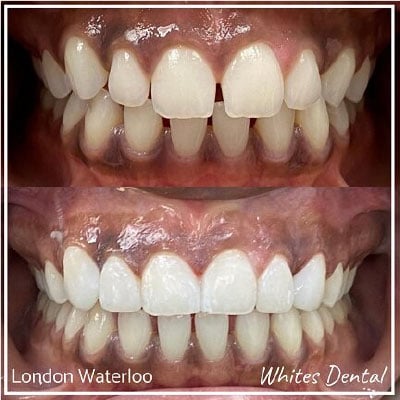Can composite bonding change your smile?
Call us on 0208 616 0590 or email us at [email protected] to book an appointment.
Have Always Wanted
little as £4/day.

Can composite bonding change your smile?
With many solutions out there to a variety of dental problems, can composite bonding change your smile?
Chipped, cracked teeth, damaged or gaps between your teeth can cause you to feel insecure about your teeth, but luckily there are a number of options available to resolve these problems.
Will composite bonding change your smile?
In most cases, composite bonding will definitely change your smile for the better.
This form of modern dentistry is a popular way to restore your smile for either cosmetic reasons or to build up tooth structure that has been lost over the years.
Using a tooth coloured resin, the composite bonding is placed onto the problem area, bonding onto the existing tooth to improve either the shape or colour. This is where it gets its name from.
When is composite bonding used?
If you’re wondering whether or not composite bonding can change your smile, first you must understand the kinds of issues that composite bonding can treat.
Although it isn’t the wonder cure for changing people’s smiles, composite bonding can fix a variety of different issues including:
- Chipped teeth
- Cracked teeth
- Worn teeth
- Small gaps between teeth
- The length of a tooth
When it comes to fixing more drastic cases, other dental solutions might have to be considered. For example, in more severe cases of teeth straightening, Invisalign might be a better long term alternative.
What does the composite bonding process involve?
The process of changing your smile with composite bonding follows a number of steps.
Step 1
Starting with the preparation of the tooth’s surface, the dentist will ensure that the tooth is ready for the dental bonding process.
Step 2
The bonding material is then applied to the tooth’s surface before moulding and shaping it to appear natural.
Step 3
A special UV light is used to harden the material.
Step 4
Ending with the composite being polished to achieve the desired finish.
Your dentist will use a shade guide to help make the decision on the colouring of your teeth. Sometimes, patients will opt to have a session of teeth whitening before this treatment. This is because the resin used in composite material cannot be whitened if the patient decides to have teeth whitening further down the line.
What are the pros and cons of composite bonding?
Composite bonding can change your smile for the better. For many, it is the best solution available, especially for the cost. However, as with every other dental cosmetic solution, there are a few pros and cons to composite bonding.
Pros
There are many benefits to getting composite bonding treatment done, which is why many people decide to go for it. Here are some of the key reasons why people choose composite bonding:
Low cost treatment – The treatment itself is not usually a high cost compared to veneers and crowns, and can often be completed in just one appointment.
Pain free – The process is fast and pain free, and an anaesthetic is not usually required unless decay is present in the tooth.
Less invasive – Composite bonding doesn’t affect your natural teeth. Some other options, such as veneers or crowns are more invasive than composite bonding and include eroding your teeth.
Cons
Composite bonding isn’t best treatment for everyone, so it’s important that you discuss your options with your dental consultant. Here are the cons of composite bonding:
Needs replacing – Composite bonding isn’t an entirely permanent solution to changing your smile. With an average life span of 4-7 years, you will need to replace your composite bonding eventually. You can find out more on our article is composite bonding permanent.
Discolouration – The resin used for dental bonding doesn’t become discoloured in the same way that your tooth does. This could mean that your tooth and bonding become two different colours, becoming somewhat unsightly.
Can break easily – Composite bonding is prone to breaking fairly easily if not taken care of properly.
Regardless of the negatives, composite bonding has become one of the more popular choices for changing a smile. Take a look at some of the composite bonding before and after images of clients who came to us to help change their smile with composite bonding.


